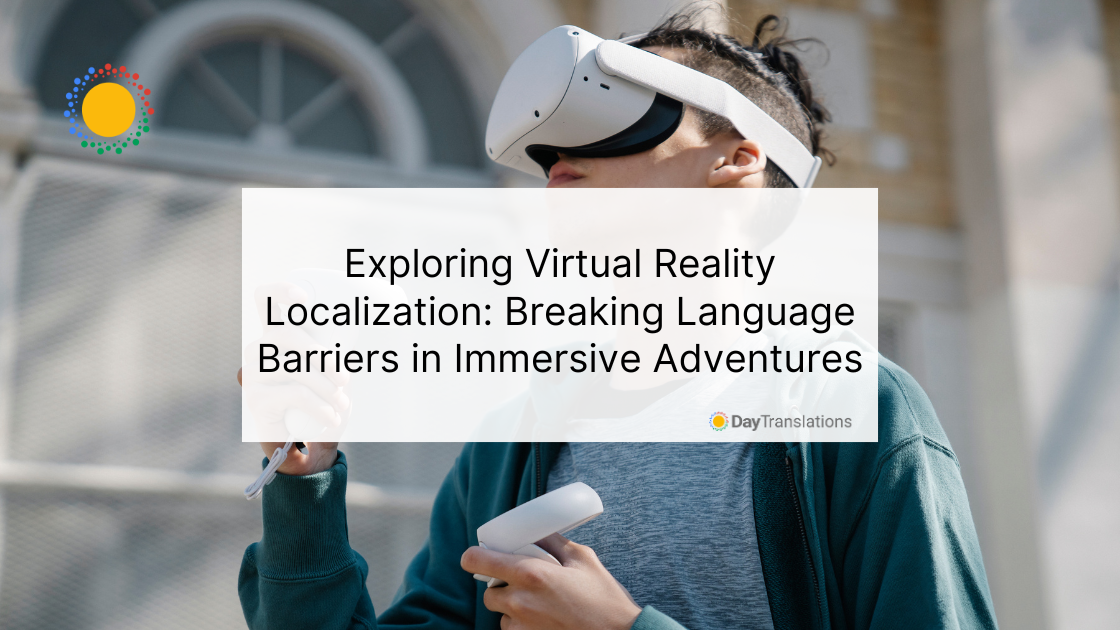Have you ever dreamed of traveling to far-off lands, conversing with people from different cultures, or immersing yourself in captivating stories? Well, hold onto your headsets because Virtual Reality localization is here to make those dreams a reality—quite literally!
What is Virtual Reality?
Picture this: you put on a headset, and suddenly, you’re not just sitting in your room anymore. You’re soaring through the skies, diving into the ocean’s depths, or even venturing into outer space! That’s the magic of Virtual Reality. VR technology creates a simulated environment that feels incredibly real, allowing you to interact with and explore imaginary worlds.
But here’s the twist – VR isn’t just about escapism. It’s also a powerful learning, communication, and cultural exchange tool. And that’s where localization comes into play.
What is Localization?
Localization is like the secret sauce that makes VR experiences accessible and enjoyable for people worldwide. Imagine you’re playing a VR game set in ancient Japan. Without localization, the dialogue, signs, and instructions might all be in Japanese, making it challenging for non-Japanese speakers to understand and enjoy the game fully. But thanks to localization, the game can be translated and adapted into different languages, ensuring that players from diverse backgrounds can fully immerse themselves in the experience.
What’s the Deal with Virtual Reality Localization?
Now, you might be wondering, “How exactly does localization work in VR?” Well, let’s break it down.
First, developers use specialized tools and techniques to identify and extract text from VR content. This could include dialogue, menu options, subtitles, and more.
Next, skilled linguists and translators work their magic, translating the text into various languages while preserving cultural context and nuances. For example, a joke that’s hilarious in English might not have the same impact when translated into Mandarin or Spanish. That’s where localization experts shine – they make sure the humor, tone, and style are tailored to each target audience.
But virtual reality localization goes beyond just text. It also involves adapting visuals, audio, and other elements to suit different cultural preferences and sensitivities. For instance, colors, symbols, and gestures that have one meaning in one culture might convey something entirely different in another. By carefully tweaking these elements, developers can create authentic and inclusive VR experiences for people from diverse backgrounds.
Why is Localization Important in VR?
Localization isn’t just a nice-to-have feature – it’s essential for creating immersive, inclusive, and impactful VR experiences. Here’s why:
Accessibility
Translating VR content into multiple languages ensures that people from different linguistic backgrounds can enjoy and understand the experience without feeling excluded or alienated.
Cultural Sensitivity
Localization helps developers avoid cultural faux pas and misinterpretations that could inadvertently offend or confuse players. VR experiences become more respectful, engaging, and meaningful by respecting and embracing cultural diversity.
Market Expansion
In today’s globalized world, reaching international audiences is key to the success of VR products and experiences. By offering localized content, developers can tap into new markets and attract a broader audience base.
Enhanced Immersion
When VR content is seamlessly localized, it feels more natural and immersive to players. Instead of being distracted by language barriers or cultural inconsistencies, players can fully immerse themselves in the virtual world and lose themselves in the adventure.
Real-World Applications of Virtual Reality Localization
Now that we understand the importance of localization in VR, let’s take a look at some real-world examples where this powerful combination is making a difference:
Educational VR Experiences
Imagine students from different countries coming together in a virtual classroom to learn about history, science, or literature. With localization, educational VR content can be tailored to each student’s native language and cultural background, fostering cross-cultural learning and collaboration.
Virtual Tourism
Want to explore the wonders of the world without leaving your living room? Virtual tourism allows you to visit iconic landmarks, bustling cities, and natural wonders in stunning detail. And with localization, you can enjoy guided tours, informative commentary, and interactive experiences in your preferred language.
Multilingual Gaming
Whether you’re battling dragons in a fantasy realm or solving puzzles in a mysterious adventure, gaming is a universal language. By localizing VR games, developers can create immersive experiences that resonate with players from diverse linguistic and cultural backgrounds, fostering a sense of community and camaraderie.
Final Thoughts
As we journey through the exciting realm of virtual reality localization, we discover a world of endless possibilities, where language barriers are no match for the power of technology and imagination. Whether we’re exploring ancient civilizations, mastering new skills, or forging connections with people around the globe, VR and localization are transforming how we experience the world – one virtual adventure at a time. So, grab your headset, embrace the magic, and let’s embark on an unforgettable journey together!












Sorry, the comment form is closed at this time.